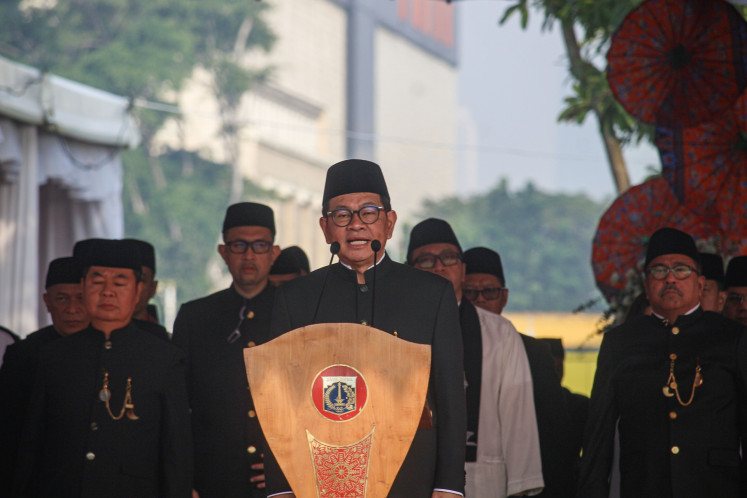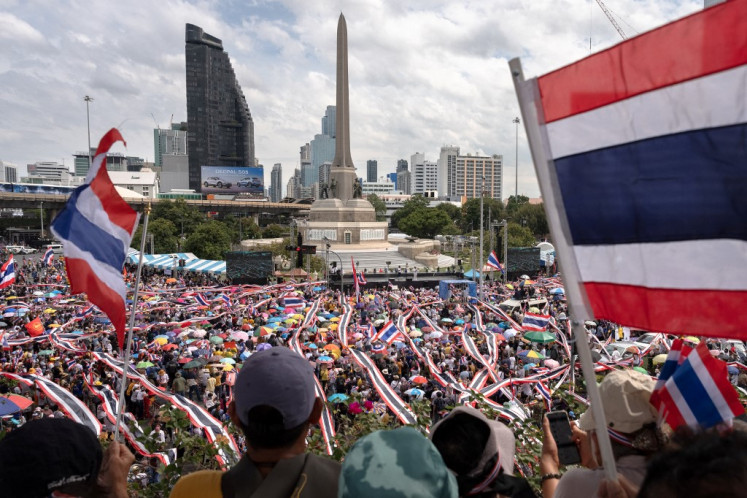Popular Reads
Top Results
Can't find what you're looking for?
View all search resultsPopular Reads
Top Results
Can't find what you're looking for?
View all search resultsWeekly 5: From sitar to ‘jaipong’; Jakarta’s street artists
Jakarta may have more shopping malls and skyscrapers than spacious and free public parks where citizens can express their artistic side
Change text size
Gift Premium Articles
to Anyone

J
akarta may have more shopping malls and skyscrapers than spacious and free public parks where citizens can express their artistic side. However, many of Jakarta’s creative minds are able to make the best use of the existing space in the capital city to perform, judging from the number and variety of traditional street performers who have decided to make a living in this very limited space.
Below are five types of city street performers who roam the streets and public places, tickling the heart of the metropolis.
‘Ondel-ondel’
Amid the noise of the capital’s busy streets, it is nice to hear snatches of Betawi music when the ondel-ondel or gigantic Betawi “human puppets” pass by, showing off a hint of Jakarta’s blurry cultural identity. “I always wait for ondel-ondel to pass by my warung [food stall], because they cheer up my grandchildren,” said Bambang, 75, a warung owner in Palmerah, West Jakarta.
For Bambang himself, the songs that accompany the ondel-ondel dance are what he enjoys the most. “Sometimes they play songs by Benyamin Sueb [a legendary Betawi artist], that I like,” he told The Jakarta Post on Thursday.
Tracing its history back to the 18th century, ondel-ondel were used to protect the community from evil spirits. Nowadays, they usually perform in festivals, parades and other festivities.
However, some ondel-ondel still travel the streets of Jakarta to entertain the passersby. The ondel-ondel dance is usually accompanied by gambang kromong, Betawi traditional music consisting of drums, gongs and rebab.
Javanese sitar performers
Donning traditional Javanese attire complete with batik sarong and blangkon (Javanese headgear), Tugimin, a Javanese sitar player, has become a signature entertainer at the Roti Bakar Eddy (Eddy’s toast) outdoor eatery in Blok M, South Jakarta.
Coming all the way from Surakarta in Central Java to the capital city, Tugimin, who has been entertaining customers since 2005, says he can earn up to Rp 500,000 (US$52) per night by singing and playing his sitar.
The 56-year-old man said that there were at least 24 Javanese sitar players from Solo and Yogyakarta, Central Java, in Jakarta who perform in various food places in the city. They are often asked to play at Javanese wedding ceremonies and at the Pasar Seni Ancol (Ancol art market) in North Jakarta.
He says that most of the Javanese songs he plays have philosophical messages in their lyrics. However, he has his own favorite tune. “One of my favorite songs is titled ‘Langgam Wuyung’, which means I miss you so much it hurts,” Tugimin told the Post, smiling.
‘Kuda lumping’
Despite the fact that it is not Central Java Governor Bibit Waluyo’s favorite traditional art, the kuda lumping or jaran kepang (bamboo horse dance) remains one of Jakarta’s favorite street performances. Performing every weekend in front of Museum Fatahillah in Jakarta’s old town, West Jakarta, the kuda lumping has gained its own fans in the city with hundreds of spectators already lined up by the time the show starts.
Originally from Central Java, the dance portrays troops riding colorful hobby horses. The dance usually incorporates magic, where the “possessed” dancers display unusual abilities, such as eating glass or stepping on flaming coals.
‘Jaipong’ dance
The city’s street performers deserve credit for helping to preserve Indonesia’s almost forgotten indigenous dances, including jaipong. Created by a noted West Java artist Gugum Gumbira, jaipong was initiated to help home-grown dance and music compete with Western popular shows, after Soekarno banned western music in 1961.
Even though it is considered a neo-traditional dance, jaipong is primarily based on village forms of the ketuk tilu dance and on pencak silat (Indonesian martial arts).
If you are lucky, the dance can be seen at traffic lights on Jakarta’s main streets and even at bus
terminals.
‘Tanjidor’
Tanjidor is a style of Betawi orchestration that is heavily influenced by European culture with instruments such as clarinets, trombones and trumpets, and is performed by seven to 10 people.
Born during the Dutch colonial era, tanjidor was initially played only by slaves for their masters.
Although there are no specific schedules, tanjidor performances can be enjoyed at the Bank Mandiri Museum in the city’s old town at weekends, as well as in city festivals and parades.









